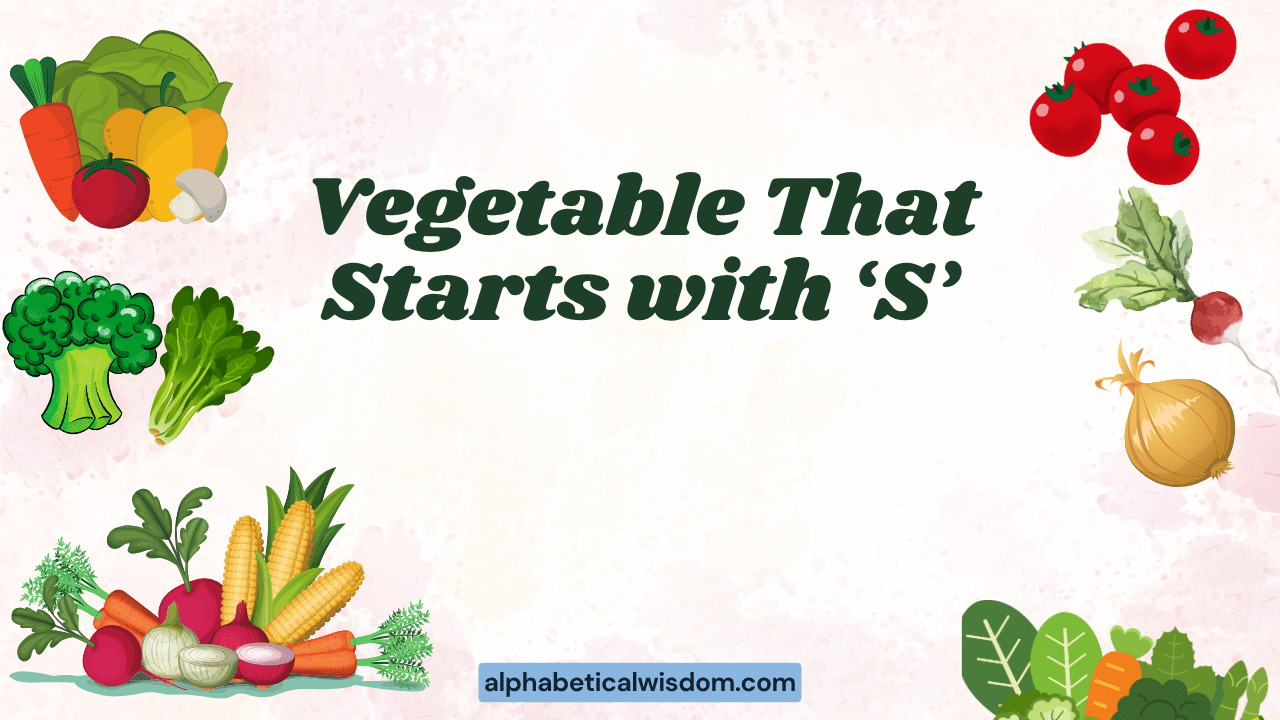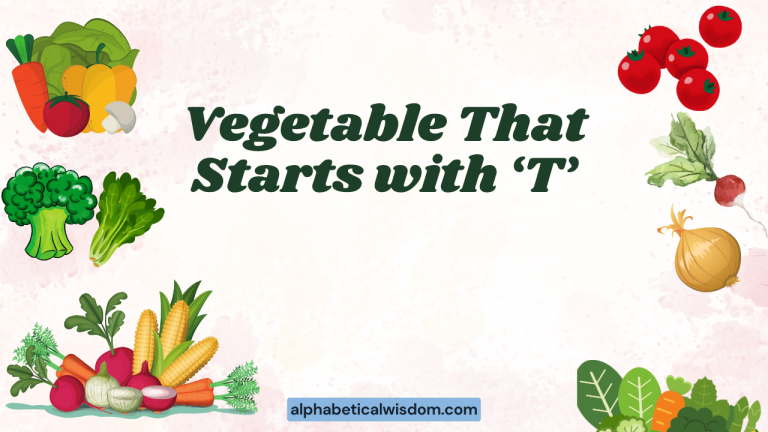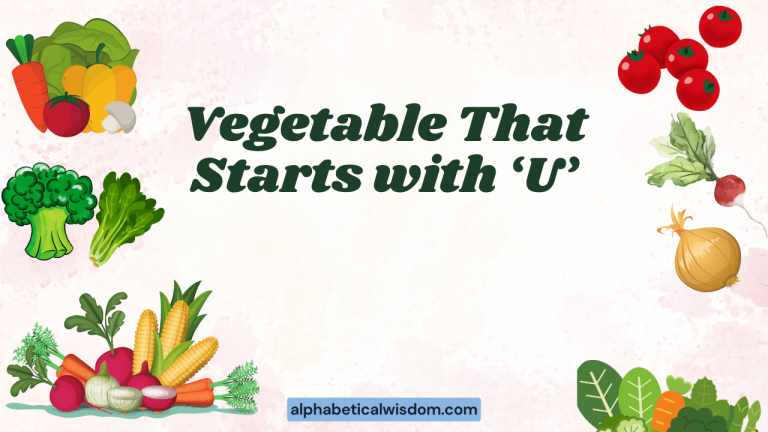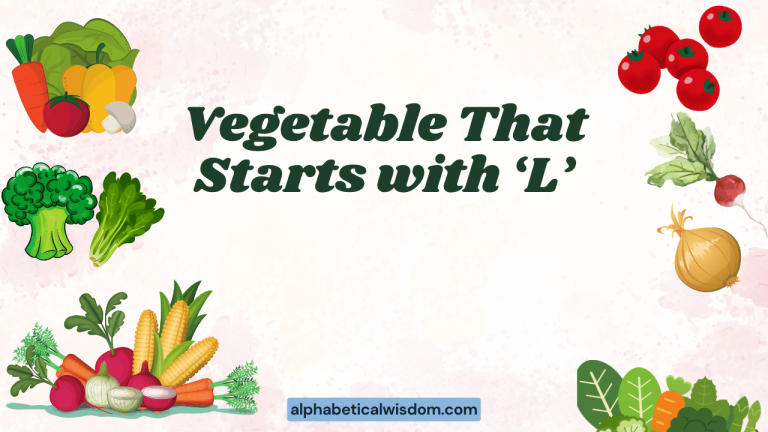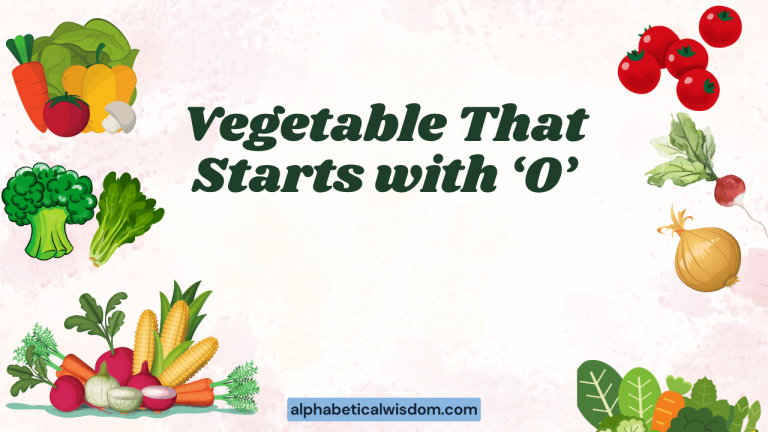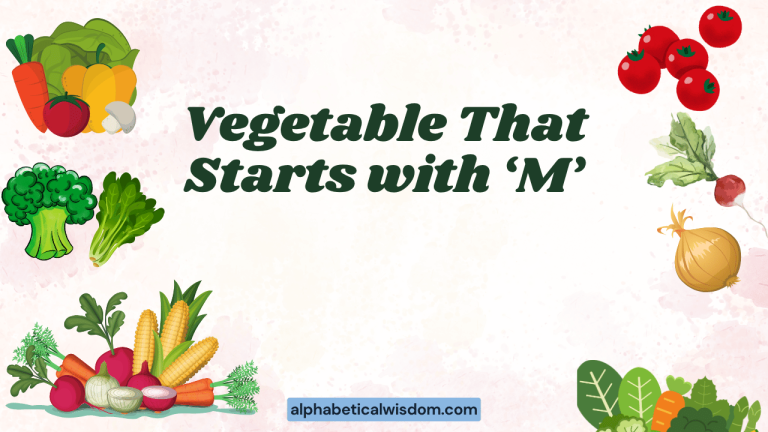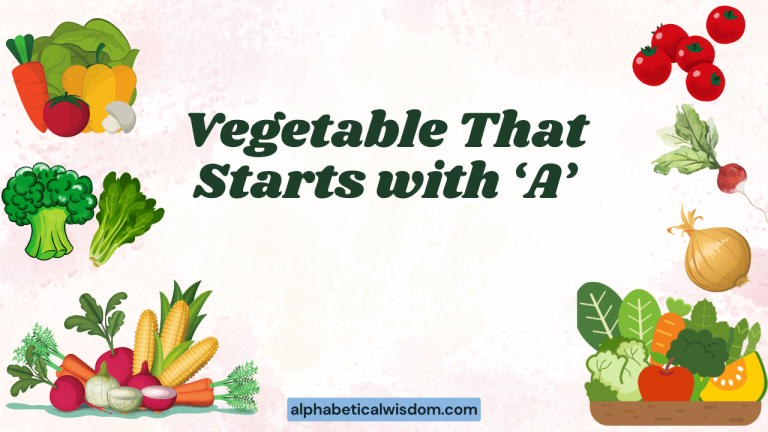Vegetables that Start with S: A Grammatical Exploration
Understanding nouns, especially concrete nouns like vegetables, is fundamental to English grammar. This article delves into the grammatical aspects of vegetables whose names begin with the letter “S,” exploring their usage, categorization, and common errors associated with them.
This guide is beneficial for English language learners, teachers, and anyone interested in expanding their vocabulary and grammatical accuracy related to culinary terms. Mastering these terms and their grammatical functions will enhance both your writing and speaking skills.
Table of Contents
- Introduction
- Definition of Vegetables
- Structural Breakdown: Noun Types
- Types of Vegetables Starting with “S”
- Examples of Usage
- Usage Rules
- Common Mistakes
- Practice Exercises
- Advanced Topics
- FAQ
- Conclusion
Definition of Vegetables
A vegetable is generally defined as any edible part of a plant that is not a fruit or seed. In culinary terms, vegetables are often savory and consumed as part of a main meal. Grammatically, vegetables are classified as concrete nouns, which means they refer to tangible objects that can be perceived by the senses. They function as subjects, objects, complements, or appositives in sentences.
Vegetables can be further categorized as countable nouns (e.g., potato, carrot) or uncountable nouns (e.g., spinach, lettuce, when referring to a general mass). This distinction affects how they are used with articles and quantifiers. For example, you can say “I ate a potato,” but you would say “I ate some spinach,” not “I ate a spinach.”
Structural Breakdown: Noun Types
Understanding the structure of nouns is essential for correct grammar. Vegetables, as nouns, adhere to specific grammatical rules.
They can be singular or plural, and their form affects verb agreement. Singular nouns require singular verbs, while plural nouns require plural verbs.
For example:
- Singular: The squash is ripe.
- Plural: The squashes are ripe.
Furthermore, nouns can be modified by adjectives, which provide more information about the vegetable. For example, “a ripe tomato” or “fresh spinach.” These adjectives precede the noun and enhance the descriptive quality of the sentence.
Nouns can also function as possessives, showing ownership or relationship. For example, “the carrot’s color” or “the farmer’s spinach.” Possessive nouns are usually formed by adding an apostrophe and an “s” (‘s) to the noun.
Types of Vegetables Starting with “S”
Several vegetables begin with the letter “S,” each with unique characteristics and grammatical considerations. Here, we will explore some of the most common ones.
Spinach
Spinach is a leafy green vegetable known for its high nutritional value. Grammatically, it is often treated as an uncountable noun when referring to a general quantity. However, you can refer to individual leaves of spinach, in which case it can be treated as countable.
Squash
Squash is a versatile vegetable that comes in various shapes, sizes, and colors. It is a countable noun. Therefore, it has both singular (squash) and plural (squashes) forms.
Sweet Potato
Sweet potato is a starchy, sweet-tasting root vegetable. It is a countable noun and follows regular pluralization rules. The plural form is “sweet potatoes.”
Shallot
A shallot is a type of onion, known for its mild flavor. It is a countable noun, with the plural form being “shallots.”
Scallion
Scallion, also known as green onion, is a type of onion with long green leaves. It is a countable noun and its plural form is “scallions.”
Swede
A swede (also known as rutabaga in North America) is a root vegetable, a cross between a turnip and a cabbage. It is a countable noun. Its plural form is “swedes.”
Salsify
Salsify is a root vegetable with a flavor that some describe as oyster-like. It is a countable noun, with the plural form being “salsifies.”
Examples of Usage
To illustrate how these vegetables are used in sentences, consider the following examples. These examples demonstrate the correct grammatical usage of each vegetable name as a noun, including singular, plural, and possessive forms.
Table 1: Spinach Examples
| Category | Example Sentence |
|---|---|
| Subject | Spinach is a healthy addition to any diet. |
| Object | I bought some fresh spinach at the market. |
| Complement | My favorite green vegetable is spinach. |
| Possessive (Rare) | The spinach’s vibrant color indicates its freshness. |
| Singular (Individual Leaf) | This spinach leaf is perfect for the salad. |
| Plural (Individual Leaves) | The spinaches were carefully washed before cooking. |
| With Adjective | Fresh spinach is best in salads. |
| With Quantifier | A bag of spinach costs two dollars. |
| Subject | Spinach, in general, is a great source of iron. |
| Object | She added spinach to her smoothie for extra nutrients. |
| Complement | One of the most nutritious leafy greens is spinach. |
| Possessive (Rare) | The spinach’s texture was slightly rough. |
| Singular (Individual Leaf) | Each spinach leaf was inspected for quality. |
| Plural (Individual Leaves) | The spinaches wilted quickly in the heat. |
| With Adjective | Tender spinach is perfect for a quick sauté. |
| With Quantifier | A handful of spinach can make a big difference in your diet. |
| Subject | Spinach grows well in cool weather. |
| Object | He prefers to eat spinach raw in salads. |
| Complement | A good source of vitamin K is spinach. |
| Possessive (Rare) | The spinach’s flavor was enhanced with lemon juice. |
| Singular (Individual Leaf) | That spinach leaf has a unique shape. |
| Plural (Individual Leaves) | The spinaches were separated and washed individually. |
| With Adjective | Organic spinach is often more expensive. |
| With Quantifier | A serving of spinach provides a significant amount of vitamins. |
Table 2: Squash Examples
| Category | Example Sentence |
|---|---|
| Singular Subject | The squash is growing rapidly in the garden. |
| Plural Subject | The squashes are ready to be harvested. |
| Singular Object | I bought a squash at the farmer’s market. |
| Plural Object | She cooked several squashes for the soup. |
| Singular Possessive | The squash’s skin is thick and hard. |
| Plural Possessive | The squashes’ colors varied from orange to green. |
| With Adjective | A large squash can feed a whole family. |
| With Quantifier | A few squashes are left in the field. |
| Singular Subject | This squash is perfect for roasting. |
| Plural Subject | These squashes are different varieties. |
| Singular Object | He carved a squash for Halloween. |
| Plural Object | They grew many squashes in their garden. |
| Singular Possessive | The squash’s flesh is sweet and tender. |
| Plural Possessive | The squashes’ seeds were saved for next year. |
| With Adjective | A ripe squash is easy to cut. |
| With Quantifier | Several squashes were donated to the food bank. |
| Singular Subject | The squash provides essential nutrients. |
| Plural Subject | The squashes are a good source of vitamins. |
| Singular Object | She sliced the squash into even pieces. |
| Plural Object | He prepared the squashes for the Thanksgiving feast. |
| Singular Possessive | The squash’s taste is enhanced with spices. |
| Plural Possessive | The squashes’ textures varied greatly. |
| With Adjective | A yellow squash is often sweeter. |
| With Quantifier | Many squashes are grown in the local farms. |
Table 3: Sweet Potato Examples
| Category | Example Sentence |
|---|---|
| Singular Subject | The sweet potato is a good source of vitamin A. |
| Plural Subject | The sweet potatoes were baked until soft. |
| Singular Object | I roasted a sweet potato for dinner. |
| Plural Object | She mashed the sweet potatoes with butter. |
| Singular Possessive | The sweet potato’s orange color is very appealing. |
| Plural Possessive | The sweet potatoes’ sweetness intensified during baking. |
| With Adjective | A large sweet potato can be quite filling. |
| With Quantifier | A few sweet potatoes are needed for the recipe. |
| Singular Subject | This sweet potato is organically grown. |
| Plural Subject | These sweet potatoes came from the local farm. |
| Singular Object | He peeled the sweet potato before cooking. |
| Plural Object | They seasoned the sweet potatoes with cinnamon. |
| Singular Possessive | The sweet potato’s texture is smooth when cooked. |
| Plural Possessive | The sweet potatoes’ flavors blended well with the spices. |
| With Adjective | A baked sweet potato is a healthy side dish. |
| With Quantifier | Many sweet potatoes are harvested in the fall. |
| Singular Subject | The sweet potato provides dietary fiber. |
| Plural Subject | The sweet potatoes are versatile in many recipes. |
| Singular Object | She added the sweet potato to the stew. |
| Plural Object | He grilled the sweet potatoes for a barbecue. |
| Singular Possessive | The sweet potato’s sweetness is a natural sugar. |
| Plural Possessive | The sweet potatoes’ nutrients are beneficial for health. |
| With Adjective | A roasted sweet potato is easy to prepare. |
| With Quantifier | Several sweet potatoes were used to make fries. |
Table 4: Shallot, Scallion, Swede, and Salsify Examples
| Vegetable | Category | Example Sentence |
|---|---|---|
| Shallot | Singular Subject | The shallot adds a mild flavor to the sauce. |
| Shallot | Plural Object | I bought several shallots at the market. |
| Scallion | Singular Subject | The scallion is a common garnish. |
| Scallion | Plural Object | She chopped the scallions finely. |
| Swede | Singular Subject | The swede is a popular root vegetable in the UK. |
| Swede | Plural Object | They roasted the swedes with other root vegetables. |
| Salsify | Singular Subject | The salsify has a unique oyster-like flavor. |
| Salsify | Plural Object | He prepared the salsifies by peeling and boiling them. |
| Shallot | Singular Possessive | The shallot’s aroma filled the kitchen. |
| Shallot | Plural Possessive | The shallots’ layers were easily separated. |
| Scallion | Singular Possessive | The scallion’s green leaves are edible. |
| Scallion | Plural Possessive | The scallions’ freshness was evident in their vibrant color. |
| Swede | Singular Possessive | The swede’s texture is similar to a turnip. |
| Swede | Plural Possessive | The swedes’ sweetness was enhanced by roasting. |
| Salsify | Singular Possessive | The salsify’s flavor is subtle and earthy. |
| Salsify | Plural Possessive | The salsifies’ preparation requires careful peeling. |
| Shallot | With Adjective | A fried shallot makes a great topping. |
| Scallion | With Adjective | Fresh scallion is perfect in salads. |
| Swede | With Adjective | Mashed swede is a classic side dish. |
| Salsify | With Adjective | Cooked salsify can be used in soups. |
Usage Rules
When using vegetable names in sentences, it’s important to follow standard grammatical rules. Subject-verb agreement is crucial. If the subject is singular, the verb must be singular; if the subject is plural, the verb must be plural. For example:
- Correct: The squash is ripe.
- Correct: The squashes are ripe.
Articles (a, an, the) are used differently depending on whether the noun is countable or uncountable. Countable nouns can be used with “a” or “an” in the singular form when the noun is nonspecific. Uncountable nouns generally do not use “a” or “an.” For instance:
- Correct: I ate a squash.
- Correct: I ate some spinach.
- Incorrect: I ate a spinach.
Quantifiers (some, many, much, few, a lot of) are used to indicate quantity. “Many” and “few” are used with countable nouns, while “much” and “a little” are used with uncountable nouns. “Some” and “a lot of” can be used with both.
- Correct: I have many squashes.
- Correct: I have much spinach.
- Correct: I have some squashes.
- Correct: I have some spinach.
When using possessive forms, remember to add an apostrophe and an “s” (‘s) to singular nouns and an apostrophe (‘) to plural nouns ending in “s.”
- Correct: The squash’s color is orange.
- Correct: The squashes’ colors are vibrant.
Common Mistakes
One common mistake is using the wrong article with uncountable nouns. For example:
- Incorrect: I want a spinach.
- Correct: I want some spinach.
Another frequent error is incorrect subject-verb agreement:
- Incorrect: The squashes is ripe.
- Correct: The squashes are ripe.
Using the wrong quantifier is also a common mistake:
- Incorrect: I have much squashes.
- Correct: I have many squashes.
Pay attention to the correct plural forms. While most nouns simply add an “s,” some have irregular plural forms.
However, the vegetable names discussed here follow regular pluralization rules.
Practice Exercises
Complete the following sentences using the correct form of the vegetable names. Choose the correct article or quantifier where necessary.
Exercise 1: Fill in the Blanks
| Question | Answer |
|---|---|
| 1. I need to buy ______ spinach for the salad. | some |
| 2. The ______ is growing well in the garden. | squash |
| 3. She cooked several ______ for the soup. | squashes |
| 4. ______ sweet potato is a good source of vitamin A. | A |
| 5. They mashed the ______ with butter. | sweet potatoes |
| 6. The ______ flavor enhances the dish. (shallot) | shallot’s |
| 7. I added ______ scallions to the soup. | some |
| 8. The ______ is a root vegetable. (swede) | swede |
| 9. He is cooking ______ salsifies for dinner. | some |
| 10. ______ squash is on sale at the market. | The |
Exercise 2: Correct the Errors
| Question | Answer |
|---|---|
| 1. I want a spinach. | I want some spinach. |
| 2. The squashes is ripe. | The squashes are ripe. |
| 3. I have much squashes. | I have many squashes. |
| 4. A sweet potato are delicious. | A sweet potato is delicious. |
| 5. The shallots is ready. | The shallots are ready. |
| 6. I like eat scallion. | I like to eat scallions. |
| 7. The swede’s are big. | The swedes are big. |
| 8. Salsify are an unusual vegetable. | Salsify is an unusual vegetable. |
| 9. Some spinach are needed. | Some spinach is needed. |
| 10. I buyed a squash. | I bought a squash. |
Advanced Topics
For advanced learners, explore the etymology of these vegetable names. Understanding the origins of words can provide deeper insights into their usage and meaning.
Also, consider the regional variations in names. For example, a “swede” is known as a “rutabaga” in North America.
These variations can lead to confusion, so it’s important to be aware of them.
Advanced learners can also investigate the use of these vegetable names in idiomatic expressions. For example, “full of beans” can be used to describe someone who is energetic, though it doesn’t directly relate to vegetables.
However, exploring such expressions can enrich your understanding of the language.
FAQ
- Is “spinach” countable or uncountable?
Generally, “spinach” is treated as an uncountable noun when referring to a general quantity. However, you can treat it as countable when referring to individual leaves (e.g., “These spinaches are fresh”).
- What is the plural form of “squash”?
The plural form of “squash” is “squashes.”
- How do I use “sweet potato” in a sentence?
You can use “sweet potato” as a subject (e.g., “The sweet potato is nutritious”), an object (e.g., “I ate a sweet potato”), or as a possessive (e.g., “The sweet potato’s color is orange”).
- Is it correct to say “a spinach”?
No, it is generally incorrect to say “a spinach.” You should say “some spinach” or “a bunch of spinach.”
- What is the difference between a shallot and an onion?
A shallot is a type of onion, but it has a milder flavor and a different shape. Shallots typically grow in clusters, while onions usually grow as single bulbs.
- Can “scallion” be used interchangeably with “green onion”?
Yes, “scallion” and “green onion” are often used interchangeably to refer to the same vegetable.
- What is another name for a swede?
In North America, a swede is commonly known as a rutabaga.
- What does salsify taste like?
Salsify has a unique flavor that some describe as oyster-like, hence it is sometimes called the “oyster plant”.
- How do I know when to use ‘some’ versus ‘a’ with vegetables?
Use ‘a’ with singular, countable vegetables like “a squash” or “a sweet potato.” Use ‘some’ with uncountable vegetables like “some spinach” or when referring to an unspecified quantity of countable vegetables, such as “some shallots.”
- What are common adjectives used to describe these vegetables?
Common adjectives include: fresh spinach, ripe squash, baked sweet potato, mild shallot, green scallion, roasted swede, and cooked salsify.
Conclusion
Understanding the grammatical properties of nouns, particularly concrete nouns like vegetable names, is crucial for accurate and effective communication. By mastering the usage of vegetables that start with “S,” such as spinach, squash, sweet potato, shallot, scallion, swede, and salsify, you can enhance your vocabulary and grammatical skills.
Remember to pay attention to countability, subject-verb agreement, and article usage. Consistent practice and attention to detail will help you avoid common mistakes and confidently use these terms in your writing and speaking.
Continue to expand your knowledge of English grammar by exploring other types of nouns and their unique characteristics. The more you practice, the more natural and fluent your language skills will become.
Happy learning!
